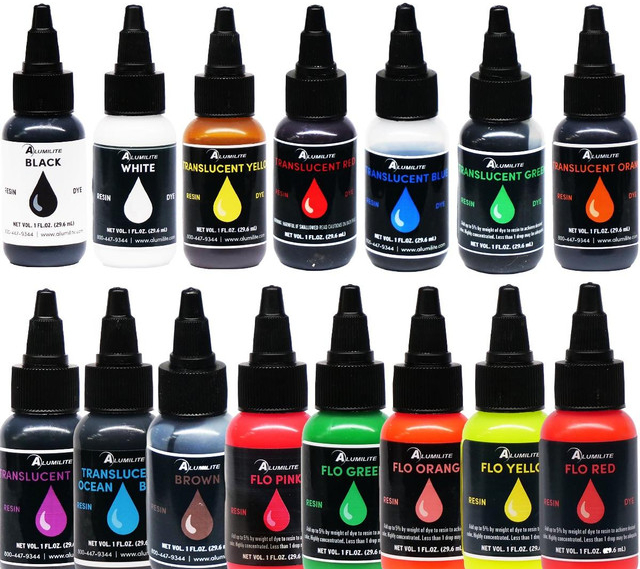Adding colorants to 3D printing resins
When you’re working on a new product or prototypes for components, it can get pretty boring to use the same colors over and over again. Luckily, there are now a variety of drops and shades that will bring any resin to life and help you achieve unique colors for your next 3D printing project. In this blog post, I describe how you can add color to your resins with custom colorants.
While we have not tested all the dye kits on the market, our users have had good experiences with Miraclekoo epoxy resin dyes and Alumilite resin dyes, both of which are suitable for mixing with epoxy resin. These are alcohol-based liquid paints that are available from online retailers or specialist woodworking stores. For Miraclekoo you need to mix 10 ml of colorant per kg of resin, whereas Alumilite is more concentrated and only a few drops per kg are sufficient. If you use Aluminite White, you may only need a few drops to achieve opacity. Monocure3D pigment dye is also an excellent choice if you want to experiment with dyes while having access to the basic cyan, magenta, yellow and black (CMYK) dyes.


If you are working with colorants, you should label your bottles well to avoid confusion. Avoid using powder-based colorants, but if you must, choose those with nano-sized particles to prevent UV radiation from being blocked when it settles to the bottom of the container. Industrial users wishing to order resins in quantities greater than 1 ton should contact their resin supplier to discuss individual color mixing options. Suppliers can offer pure colors that match any Pantone® specification.
The beauty of the Nexa3D resin 3D printers is that they are built on an open material platform and you have the ability to use and experiment with third-party resins. You will need a Pro license of the NexaX software to use the menu with the user-defined settings. Normally you have to adjust the exposure time to obtain dimensionally accurate parts. Dyes are known to absorb or scatter UV rays, which means that the exposure time must be extended to achieve the same UV exposure of the resin layer. While blue and violet dyes absorb the least UV, yellow-red dyes absorb the most. An increase in exposure time of 1-15% is therefore normal.
You can add dyes to translucent or clear photopolymer resins to obtain a translucent color, or to white and almost white resins to obtain an opaque color. However, it should be noted that some photopolymer resins use yellowing photoinitiators that turn slightly more yellow after curing. Therefore, you can observe a certain color shift after curing. It is recommended to use ultra-clear or pure white resins, which use a different photoinitiator that does not yellow as much. Some of the recommended materials to start with are xMODEL17-Clear and PRO9499-White.
Adding color to 3D print resinsis a great way to achieve custom colors for your prints. Regardless of whether you want to use translucent or opaque colors, dyes offer a convenient way to get the colors you want. Remember that working with dyes is not covered by the warranty. Therefore, find out about the curing times and mechanical properties of your materials. By following these tips, you’ll be well on your way to achieving fantastic custom colors for your next 3D prints.


